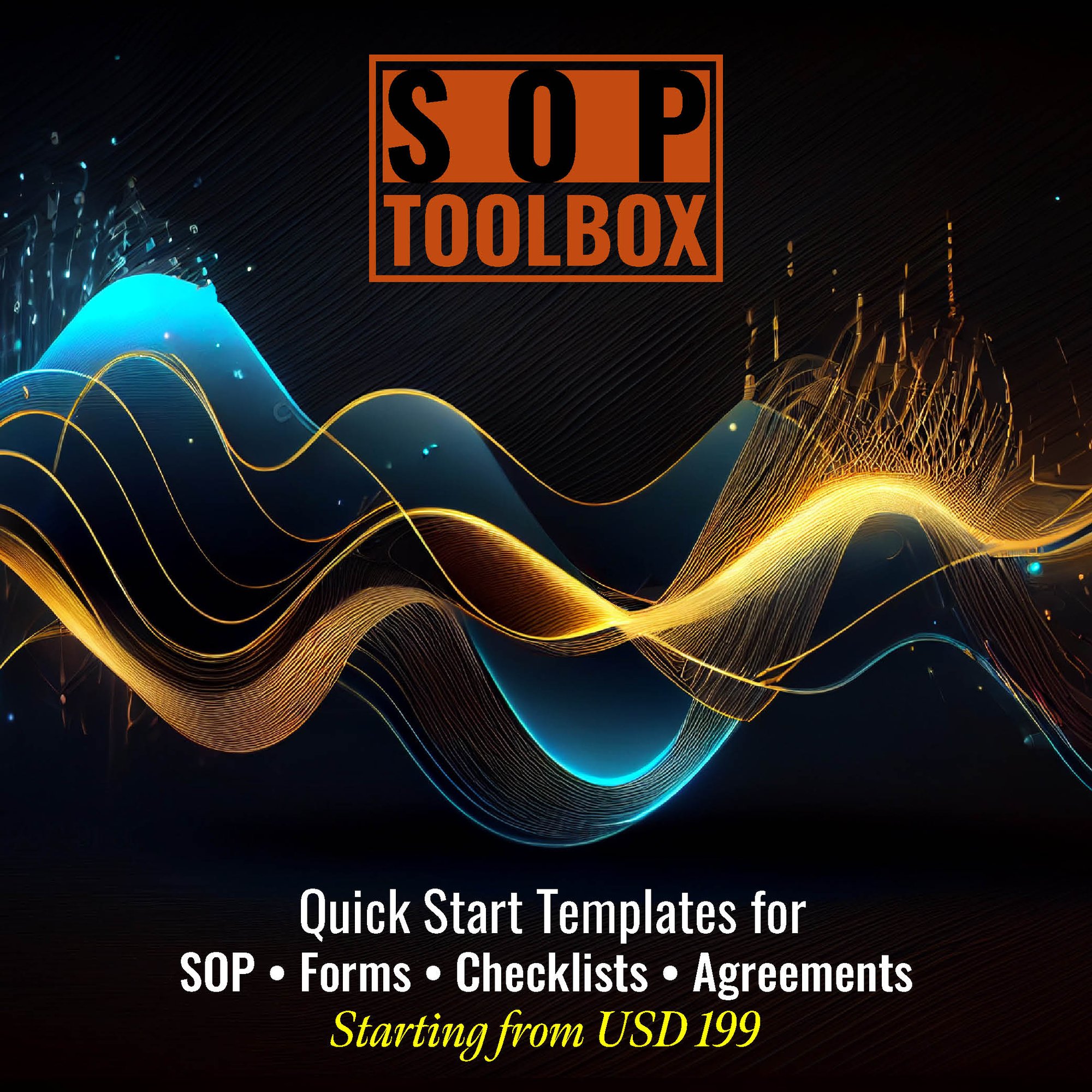An SOP (Standard Operating Procedure) Manual for Tissue Culture is of profound significance in the fields of biology, medicine, and agriculture. Here are some key reasons for its noteworthiness:
-
Precision and Reproducibility: Tissue culture techniques are essential for growing and maintaining cells, tissues, and organs in a controlled environment. The manual provides step-by-step procedures for culturing, ensuring accuracy, reproducibility, and reliable results in research, drug development, and crop improvement.
-
Quality Control: It establishes rigorous quality control measures for tissue culture processes, minimizing contamination, mutation, and other sources of variability. This is critical for maintaining the integrity of experimental results and the quality of products like pharmaceuticals and disease-resistant crops.
-
Safety: The manual outlines safety protocols for handling biological materials and potentially hazardous agents, protecting laboratory personnel and the environment from risks associated with tissue culture.
-
Regulatory Compliance: It assists in compliance with regulatory requirements, particularly in fields such as pharmaceuticals and biotechnology, where adherence to strict quality standards and ethical guidelines is imperative.
-
Training and Skill Development: The manual serves as a valuable tool for training new staff and continually enhancing the skills of personnel involved in tissue culture, ensuring a competent and knowledgeable workforce.
In summary, an SOP Manual for Tissue Culture is noteworthy for ensuring precision, quality control, safety, regulatory compliance, and skill development in scientific research, medical applications, and agricultural advancements, thereby underpinning progress in numerous fields.
CLICK HERE to download the List of SOPs Document in PDF format. Please share this document with your clients, colleagues and senior officers.
Top 50 Standard Operating Procedures (SOPs) for Tissue Culture
SOP-928-001: Standard Operating Procedure for Tissue Culture Facility Access
SOP-928-002: Standard Operating Procedure for Personal Protective Equipment (PPE) Usage
SOP-928-003: Standard Operating Procedure for Work Area Preparation
SOP-928-004: Standard Operating Procedure for Equipment Sterilization
SOP-928-005: Standard Operating Procedure for Media Preparation
SOP-928-006: Standard Operating Procedure for Cell Line Authentication
SOP-928-007: Standard Operating Procedure for Culture Vessel Preparation
SOP-928-008: Standard Operating Procedure for Seeding Cells
SOP-928-009: Standard Operating Procedure for Routine Cell Passaging
SOP-928-010: Standard Operating Procedure for Cryopreservation
SOP-928-011: Standard Operating Procedure for Thawing Cryopreserved Cells
SOP-928-012: Standard Operating Procedure for Cell Counting
SOP-928-013: Standard Operating Procedure for Contamination Prevention
SOP-928-014: Standard Operating Procedure for Monitoring Cell Culture Parameters
SOP-928-015: Standard Operating Procedure for Cell Line Documentation
SOP-928-016: Standard Operating Procedure for Record Keeping
SOP-928-017: Standard Operating Procedure for Waste Disposal
SOP-928-018: Standard Operating Procedure for Emergency Response
SOP-928-019: Standard Operating Procedure for Incubator Use and Monitoring
SOP-928-020: Standard Operating Procedure for Microscope Operation
SOP-928-021: Standard Operating Procedure for Reagent Storage and Handling
SOP-928-022: Standard Operating Procedure for Antibiotic Usage
SOP-928-023: Standard Operating Procedure for Mycoplasma Testing
SOP-928-024: Standard Operating Procedure for pH Measurement
SOP-928-025: Standard Operating Procedure for Temperature Monitoring
SOP-928-026: Standard Operating Procedure for Carbon Dioxide (CO2) Monitoring
SOP-928-027: Standard Operating Procedure for Equipment Calibration
SOP-928-028: Standard Operating Procedure for Disposal of Biological Materials
SOP-928-029: Standard Operating Procedure for Cross-Contamination Prevention
SOP-928-030: Standard Operating Procedure for Laboratory Hygiene
SOP-928-031: Standard Operating Procedure for Cell Line Characterization
SOP-928-032: Standard Operating Procedure for Media Change
SOP-928-033: Standard Operating Procedure for Handling Hazardous Chemicals
SOP-928-034: Standard Operating Procedure for Biosafety Cabinet Use
SOP-928-035: Standard Operating Procedure for Equipment Maintenance
SOP-928-036: Standard Operating Procedure for Quality Control Checks
SOP-928-037: Standard Operating Procedure for Aseptic Technique
SOP-928-038: Standard Operating Procedure for Sample Collection
SOP-928-039: Standard Operating Procedure for Cell Viability Assessment
SOP-928-040: Standard Operating Procedure for Subculturing Cells
SOP-928-042: Standard Operating Procedure for Genomic DNA Extraction
SOP-928-043: Standard Operating Procedure for RNA Extraction
SOP-928-044: Standard Operating Procedure for Protein Extraction
SOP-928-045: Standard Operating Procedure for Western Blotting
SOP-928-046: Standard Operating Procedure for Immunocytochemistry
SOP-928-047: Standard Operating Procedure for Flow Cytometry
SOP-928-048: Standard Operating Procedure for Confocal Microscopy
SOP-928-049: Standard Operating Procedure for Single-Cell Isolation
SOP-928-050: Standard Operating Procedure for Facility Decontamination
SOP ToolBox: If you are reading these lines, I am sure you are looking for Standard Operating Procedure guidelines or SOPs itself. In both the cases, searching in internet will not be yielding any great help. Because no company shares their SOP Development Process and certainly don’t share their SOP Documents. The best way to develop an SOP is creating one for yourself. At Fhyzics, we write SOPs day-in and day-out for companies across the globe including some of the Fortune 500 organisations. Our charge ranges from USD 5000 to USD 50000 depending upon the number of processes to be covered. Certainly, this is not affordable to small and mid-size organisations. Hence, we decided to create this SOP ToolBox to disseminate our 8-Step SOP Development Life-Cycle and best practices at an unbelievably low price.
I always say, writing an SOP is somewhere between art and science. So far you may be clueless on where to start and how to progress on an SOP? This will not be the case after you diligently go through this SOP ToolBox. We have summarised all our secrets here to get you started and to deliver a stunning SOP to your management.
-
Clonal Propagation and Micro-Propagation
-
Biomass Energy
-
Secondary Metabolites
-
Genetic Variability
-
Somatic Embryogenesis and Synthetic Seed
-
Breaking Dormancy
-
Haploid Plants
-
Somatic Hybrids
-
Transgenic Plants
-
Germplasm Conservation
1. Standard Operating Procedures (SOP) Manual for Accounts Department
2.Standard Operating Procedures (SOP) Manual for Finance Department
3. Standard Operating Procedures (SOP) Manual for Customer Service
4. Standard Operating Procedures (SOP) Manual for CRM Department
5. Standard Operating Procedures (SOP) Manual for Credit Department
6.Standard Operating Procedures (SOP)Manual for Treasury Department
7.Standard Operating Procedures (SOP) Manual for Human Resources (HR) Department
8. Standard Operating Procedures (SOP) Manual for Training Department
9. Standard Operating Procedures (SOP) Manual for Learning & Development Department
10. Standard Operating Procedures (SOP) Manual for Administration Department
11. Standard Operating Procedures (SOP) Manual for Front Office
12. Standard Operating Procedures (SOP) Manual for House Keeping
13. Standard Operating Procedures (SOP) Manual for Safety Department
14. Standard Operating Procedures (SOP) Manual for Security Department
15. Standard Operating Procedures (SOP) Manual for Facilities Management Department
16. Standard Operating Procedures (SOP) Manual for Vigilance Department
17. Standard Operating Procedures (SOP) Manual for Legal Department
18. Standard Operating Procedures (SOP) Manual for Information Technology (IT) Department
19. Standard Operating Procedures (SOP) Manual for Sales & Marketing Department
20. Standard Operating Procedures (SOP) Manual for Design & Engineering
21.Standard Operating Procedures (SOP) Manual for Procurement Department
22. Standard Operating Procedures (SOP) Manual for Production
23. Standard Operating Procedures (SOP) Manual for SRM Department
24.Standard Operating Procedures (SOP) Manual for Supply Chain Department
25. Standard Operating Procedures (SOP) Manual for Warehouse
26. Standard Operating Procedures (SOP) Manual for New Product Development Department
27. Standard Operating Procedures (SOP) Manual for Research and Development
28. Standard Operating Procedures (SOP) Manual for Quality Department
29. Standard Operating Procedures (SOP) Manual for Calibration Department
30. Standard Operating Procedures (SOP) Manual for Maintenance Department
Types of Tissue Culture:
- Primary Culture: Several different types of culture are routinely performed. These can be roughly divided into "primary culture" and "culture of established cell lines." Primary culture can consist of the culture of a complex organ or tissue slice, a defined mixture of cells, or highly purified cells isolated directly from the organism.
- Established Cell Lines: The second type of cell culture is the culture of established or immortal cell lines. The vast majority of these are derived from tumours (e.g., HeLa) or from cells transformed in vitro, although some of the very earliest lines were established from normal embryonic tissue (e.g., 3T3, CHO). There are also lines that have been widely used, such as WI-38, which are from normal human tissue and have a limited life span in vitro. These cell lines have been the workhorses of cell culture, from their use in studying the control of the cell cycle to vaccine production and large-scale industrial production of recombinant proteins in 12,000 litre tanks.
Using cell and tissue cultures, at least in basic studies, aims at a better understanding of biochemical, physiological, and anatomical reactions of selected cell material to specified factors under controlled conditions, with the hope of gaining insight into the life of the intact plant also in its natural environment. Compared to the use of intact plants, the main advantage of these systems is a rather easy control of chemical and physical environmental factors to be kept constant at reasonable costs. Here, the growth and development of various plant parts can be studied without the influence of remote material in the intact plant body. In most cases, however, the original histology of the cultured material will undergo changes, and eventually may be lost. In synthetic culture media available in many formulations nowadays, the reaction of a given cell material to selected factors or components can be investigated. As an example, cell and tissue cultures are used as model systems to determine the influences of nutrients or plant hormones on development and metabolism related to tissue growth. These were among the aims of the “fathers” of tissue cultures in the first half of the 20th century.
With many emerging diseases this market is set to have an extended research and development with the demand to find cures to diseases and regeneration of cells will have extensive factor on its growth.
Market insights:
The cell culture market is expected to reach USD 29.2 billion by 2024 from USD 16.0 billion in 2019, at a growth rate of 12.7% during the forecast period. This market is experiencing significant growth due to the increasing demand for monoclonal antibodies, rising funding for cell-based research, growing preference for single-use technologies, growing awareness about the benefits of cell culture-based vaccines, and increasing focus on personalized medicine.
-
Becton, Dickinson and Company in New Jersey, United States |
-
Thermo Fisher Scientific in Massachusetts, United States |
-
Merck Group in Darmstadt, Germany |
-
HiMedia Laboratories Pvt. Ltd. In Einhausen, Germany |
-
GE Healthcare in Illinois, United States |
-
PromoCell in Heidelberg, Germany |
This SOP is an overview of Tissue culture. Application for tissue culture, Types of tissue culture, Market insights, popular companies involved in this industry are all discussed and listed above.
Research By : Eshwaran Murugappan
Please click here to review the SOP Templates’ Terms & Conditions.
Keywords: sop, manual, policy, sop meaning, sop full form, standard operating procedure, full sop, user manual, sop is, user guide, instruction manual, owners manual, sample sop, operators manual, sop example,standard operating procedure examples, abbreviation sop, standard operating procedure sample, milk sop, sop document, sop process,m manual, operating procedures, operating process, sop meaning in hindi, standard procedure, sop standard operating procedure, sop top, sop writing, standard operating procedures manual, sop meaning in english, sample sop for mba, standard operating procedures examples in office, product manual, sample sop for ms, maintenance manual, sop security, sop in research, sop in business, whats sop, standard of operation, sop set, sop procedure, sop marketing,sop training, sop hotel, sop, sop meaning business, sop form, sba sop,sop software, help manual, sop it, army sop, company sop, sop sap, o m manual, standard operating procedure examples for small business, shop manual, sop manual, sop meaning in business, purpose of standard operating procedures, sop full meaning, standard operating procedure meaning, sop military, sop standard, sop meaning medical, hr sop, sop production, purpose of sop, sop management, warehouse sop, sales sop, sop pharma, sop manufacturing, sop creation, sop laboratory, ms sop, sop full form in hindi, sop front office, sop customer service, sop online, gmp sop, sop purchasing, sop pharmacy, sop safety, sop for project management,sample sop for australian student visa, sop meaning in tamil, sop system, best sop, sop up, sop in english, sop for mechanical engineering, sop for university,sop in malay, sop lab, sop for business analytics, sop model, sop in pharmacy, developing sops, standard operating procedure examples manufacturing, sop full form in retail,sop full form in medical, sop engineering, sop application, writing standard operating procedures, procurement sop, sop maintenance,standard operating procedure nhs, sop clinical trial, sop operations,sop in construction, operating procedures manual, standard operating procedure ppt, standard procedure meaning, sop ppt, a sop, sop document meaning, sop def, sop full form in safety, sop quality control, sop for college, sop quality, sop service, types of sop, sop for engineering management, sop document sample, benefit of sop, preparing sop, standard operating procedure in hindi, sop for visa, sop compliance, sop protocol, sop aviation, sop meaning in chat, standard operating process, sop meaning military, sop for business management, standard operating procedure software, sop list, sop medical, sop logistics, sop project, sop for it department, sop call center, standard work procedures, sba sop 50 10, sop meaning in logistics, standard operating procedure laboratory, test sop, sop sample for ms, drafting sop, sops meaning in tamil, sops meaning in telugu, sop automotive, standard operating system, sop cafe, sop slideshare, sop ap, sop bank, sop in retail, creating standard operating procedures, sop admin, document control sop, pharmaceutical sop,sop in pharmaceutical industry, statement of purpose harvard, sop examples for ms, quality assurance sop, sop in clinical research, nursing sop, sop for transportation, sop policies, sops are specific to a process, sop in hindi, standard operating procedure for warehouse picking, master sop, list of sop for pharma, pharmaceutical sop examples, types of standard operating procedures, retail sop, sample sop for ms in mechanical engineering, standard operating protocol,sop supply chain, system operating procedure, sop rules, example of sop in research, sop in food industry, sop for international business management, sop for hospitality management, sop for hr department, army sop example, sop standard operating, office sop, hr standard operating procedures, preventive maintenance sop, sop for purchase department, human resources sop, fire department sops, information technology sop, operating procedure example, administration sop,sop for retail store, indian sop, construction management sop, sop hotel front office, example sop document, standard and procedures,working sop, sop for maintenance department, sop hrd department,sop full form in hotel industry, sop full, sop for human resource management, laboratory sop examples, standard operating procedure for quality control, sop for ms in mechanical engineering, sop meaning army, security standard operating procedures, sop machine, sample sop for internship, sop for hotel management, sample sop for masters, qa sop, developing standard operating procedures, standard operating procedure document, product recall sop, marketing statement of purpose, it standard operating procedures, equipment sop, sop purpose example, sop shipping, sop for sales and marketing,converting pos to sop, workshop sop, standard operating procedure manufacturing, digital marketing standard operating procedures, following standard operating procedures, sop ki full form, sop for nursing procedures, an sop, purchase sop for manufacturing company, sop a, statement of purpose for mba marketing, full meaning of sop, sop for research internship, research sop sample,vendor qualification sop, sop purchasing and receiving, sop meaning in visa, sop for admission, standard operating procedure medical office, sop in industry, sop sales marketing, navy sop, project management standard operating procedures, sop it support, standard operating manual, security operating procedures, statement of purpose for international business, procurement standard operating procedures, communication sop, sop full form in pharma, minimum sop, sop health and safety, product sop, sop for marketing department, sop in medical terms, sales standard operating procedure, sop purchase order, department sop, customer service standard operating procedures, clinical sop, marketing standard operating procedure, sop standard operating procedure example, construction standard operating procedures, standard of operations procedures manual sample, sop for facility management, sop full form in education, standard operating procedure in food industry, visa sop,sop for business administration, company sop meaning, sop work, sop operating procedure, sop for summer internship in engineering sample, general administration sop, sop for administrative duties.
Our SOP Templates’ clients are from the following States and Countries:
Alabama, Alaska, Arizona, Arkansas, California, Colorado, Connecticut, Delaware, Florida, Georgia, Hawaii, Idaho, Illinois, Indiana, Iowa, Kansas, Kentucky, Louisiana, Maine, Maryland, Massachusetts, Michigan, Minnesota, Mississippi, Missouri, Montana, Nebraska, Nevada, New Hampshire, New Jersey, New Mexico, New York, North Carolina, North Dakota, Ohio, Oklahoma, Oregon, Pennsylvania, Rhode Island, South Carolina, South Dakota, Tennessee, Texas, Utah, Vermont, Virginia, Washington, West Virginia, Wisconsin, Wyoming.
Afghanistan, Albania, Algeria, Andorra, Angola, Antigua and Barbuda, Argentina, Armenia, Australia, Austria, Azerbaijan, Bahamas, Bahrain, Bangladesh, Barbados, Belarus, Belgium, Belize, Benin, Bhutan, Bolivia, Bosnia and Herzegovina, Botswana, Brazil, Brunei Darussalam, Bulgaria, Burkina Faso, Burundi, Cabo Verde, Cambodia, Cameroon, Canada, Central African Republic, Chad, Chile, China, Colombia, Comoros, Congo (Republic of the), Costa Rica, Croatia, Cuba, Cyprus, Czech Republic (Czechia), Democratic People’s Republic of Korea (North Korea), Democratic Republic of the Congo, Denmark, Djibouti, Dominica, Dominican Republic, Ecuador, Egypt, El Salvador, Equatorial Guinea, Eritrea, Estonia, Eswatini, Ethiopia, Fiji, Finland, France, Gabon, Gambia, Georgia, Germany, Ghana, Greece, Grenada, Guatemala, Guinea, Guinea-Bissau, Guyana, Haiti, Honduras, Hungary, Iceland, India, Indonesia, Iran, Iraq, Ireland, Israel, Italy, Jamaica, Japan, Jordan, Kazakhstan,Kenya, Kiribati, Kuwait, Kyrgyzstan, Lao People’s Democratic Republic (Laos), Latvia, Lebanon, Lesotho, Liberia, Libya, Liechtenstein, Lithuania, Luxembourg, Madagascar, Malawi, Malaysia, Maldives, Mali, Malta, Marshall Islands, Mauritania, Mauritius, Mexico, Micronesia (Federated States of), Moldova, Monaco, Mongolia, Montenegro, Morocco, Mozambique, Myanmar (Burma), Namibia, Nauru, Nepal, Netherlands, New Zealand, Nicaragua, Niger, Nigeria, North Macedonia (formerly Macedonia), Norway, Oman, Pakistan, Palau, Panama, Papua New Guinea, Paraguay, Peru, Philippines, Poland, Portugal, Qatar, Republic of Korea (South Korea), Republic of the Congo, Romania, Russian Federation (Russia), Rwanda, Saint Kitts and Nevis, Saint Lucia, Saint Vincent and the Grenadines, Samoa, San Marino, Sao Tome and Principe, Saudi Arabia, Senegal, Serbia, Seychelles, Sierra Leone, Singapore, Slovakia, Slovenia, Solomon Islands, Somalia, South Africa, South Sudan, Spain, Sri Lanka, Sudan, Suriname, Sweden, Switzerland, Syrian Arab Republic (Syria), Tajikistan, Thailand, Timor-Leste, Togo, Tonga, Trinidad and Tobago, Tunisia, Turkey, Turkmenistan, Tuvalu, Uganda, Ukraine, United Arab Emirates, United Kingdom of Great Britain and Northern Ireland, United Republic of Tanzania, United States of America, Uruguay, Uzbekistan, Vanuatu, Venezuela, Viet Nam, Yemen, Zambia, Zimbabwe.
Fhyzics supports organisations in developing the following documentations:
Standard Operating Procedures (SOPs), Work Instructions, Policies and Procedures, Process Flow Diagrams, Job Descriptions, Training Manuals, Employee Handbooks, Compliance Guidelines, Quality Assurance Manuals, Health and Safety Procedures, Risk Management Plans, Business Continuity Plans, Internal Audit Procedures, Incident Reporting Forms, Performance Management Guidelines, Change Management Procedures, Vendor Management Guidelines, Customer Service Protocols, IT Security Policies, IT Support Documentation, Disaster Recovery Plans, Operational Checklists, Data Management Policies, Confidentiality Agreements, Non-Disclosure Agreements, Employee Onboarding Procedures, Employee Exit Procedures, Performance Appraisal Forms, Employee Code of Conduct, Conflict Resolution Procedures, Product Development SOPs, Supply Chain Management Guidelines, Procurement Guidelines, Inventory Management SOPs, Shipping and Receiving Procedures, Production Scheduling SOPs, Maintenance Procedures, Equipment Calibration Documents, Environmental Compliance Documentation, Sustainability Policies, Customer Feedback Forms, Marketing Strategies, Advertising Guidelines, Brand Management Guidelines, Product Packaging SOPs, Laboratory Testing Procedures, Regulatory Compliance Documentation, Tax and Accounting Procedures, Contract Management Procedures, Legal Compliance Guidelines, Financial Reporting Procedures, Budgeting Procedures, Internal Control Procedures, Fraud Prevention Policies, Asset Management Guidelines, Purchase Order Procedures, Sales and Distribution Guidelines, Client Contracts, Customer Return Policies, Internal Communication Protocols, Vendor Evaluation Forms, Product Safety Standards, Workplace Health and Safety Standards, Public Relations Procedures, Social Media Management Guidelines, Crisis Management Plans, Employee Grievance Procedures, Privacy and Data Protection Policies, Digital Transformation Guidelines, Innovation Management Procedures, Continuous Improvement Guidelines, Strategic Planning Documents, Corporate Social Responsibility (CSR) Guidelines, Audit Trails and Records, Employee Training and Development Records, Succession Planning Documents, Talent Acquisition Procedures, Team Collaboration Protocols, Employee Benefit Plans, Workplace Diversity Guidelines, Time and Attendance Tracking, Payroll Procedures, Employee Leave Policies, Conflict of Interest Policy, Emergency Response Procedures, Environmental Impact Assessment Procedures, Transportation and Logistics Procedures, Inventory Control Forms, Warehouse Management Guidelines, Product Lifecycle Management SOPs, Customer Satisfaction Surveys, Third-Party Risk Assessment Guidelines, Technology Adoption Policies, Software Licensing Guidelines, Security Incident Response Procedures, Supply Chain Risk Management Policies, Product Recall Procedures, Food Safety Guidelines, Employee Wellness Programs, Workplace Ergonomics Guidelines.






.jpg?width=645&height=337&name=Standard%20Operating%20Procedure%20-%20SOP%20ToolBox%20(1).jpg)











